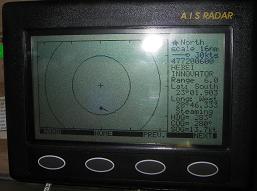 Earlier I mentioned AIS (Automated Identification System). This is a relatively new standard that involves ships transmitting name, position, course and speed information automatically. All ships over 300 tons are now required to have AIS transmitters. This basically means all cargo ships, but only the largest fishing vessels. We installed an AIS receiver in the Canaries. I bought the only one available there at the time, called an “AIS Radar” by the vendor, NASA Marine Ltd (a UK marine electronics company). The name is misleading, it has absolutely nothing to do with radar.On the screen, the cross in the centre is the receiver (my boat). North is up. The circle with a line behind it is the ship detailed on the right, the HEBEI INNOVATOR. The direction the line attached to the circle comes from gives you some visual idea of how close the ship will come to you. On the right you can see the course over the ground (COG), heading, speed, position and range (distance away) of HEBEI INNOVATOR. There is an alarm that sounds (usually) when a ship comes into range. Occasionally the unit will display a target, but never sound the alarm. It is not clear from the minimal instructions that came with the unit why the alarm does not always sound. Despite that, as long as you periodically have a look at the screen when in poor visibility, it does a great job of alerting you to the presence of ships. We usually are alerted by the AIS before we see the ships–typically they show up on the AIS when 12-16 miles away (mostly because the antenna is mounted fairly high up).
Earlier I mentioned AIS (Automated Identification System). This is a relatively new standard that involves ships transmitting name, position, course and speed information automatically. All ships over 300 tons are now required to have AIS transmitters. This basically means all cargo ships, but only the largest fishing vessels. We installed an AIS receiver in the Canaries. I bought the only one available there at the time, called an “AIS Radar” by the vendor, NASA Marine Ltd (a UK marine electronics company). The name is misleading, it has absolutely nothing to do with radar.On the screen, the cross in the centre is the receiver (my boat). North is up. The circle with a line behind it is the ship detailed on the right, the HEBEI INNOVATOR. The direction the line attached to the circle comes from gives you some visual idea of how close the ship will come to you. On the right you can see the course over the ground (COG), heading, speed, position and range (distance away) of HEBEI INNOVATOR. There is an alarm that sounds (usually) when a ship comes into range. Occasionally the unit will display a target, but never sound the alarm. It is not clear from the minimal instructions that came with the unit why the alarm does not always sound. Despite that, as long as you periodically have a look at the screen when in poor visibility, it does a great job of alerting you to the presence of ships. We usually are alerted by the AIS before we see the ships–typically they show up on the AIS when 12-16 miles away (mostly because the antenna is mounted fairly high up).
